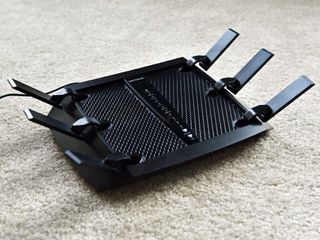

The long and steady march of technology has brought newer and more complex acronyms to Wi-Fi routers. The latest is MU-MIMO, which stands for multi-user, multiple-input, multiple-output. Released with the 802.11ac Wave 2 wireless standard back in 2013, it is being employed in many new wireless routers and new devices, and it jumps the hurdles of older technologies to enable faster and more stable wireless connections.
- What is SU-MIMO and MU-MIMO?
- The downside of MU-MIMO
- Do I need MU-MIMO?
- Which devices are compatible with MU-MIMO?
- Which routers use MU-MIMO?
What is SU-MIMO and MU-MIMO?
The majority of routers today employ SU-MIMO technology that, while providing wireless internet to multiple devices, has its limitations. SU-MIMO was introduced with the 802.11n wireless standard in 2009.
SU-MIMO allows you to connect multiple devices to the same wireless router, but the transmission of data can only happen to one device at a time. The router rapidly switches communications between devices — so fast that you normally won't notice — but when you're doing something that requires lag-free internet, you're going to see performance issues. For example, if you're gaming online while someone else is streaming video, you might end up dead before you have a chance to shoot back.
MU-MIMO amps things up by allowing your router to communicate simultaneously with multiple devices — no switching here. It's like each device gets its own virtual router. There are variations on MU-MIMO: 2x2 can handle two simultaneous streams, 3x3 can do three, and 4x4 MU-MIMO can handle simultaneous transmission with up to three devices. With MU-MIMO you'll find your connection is more stable and has a lower latency.
The downside of MU-MIMO
There are some things to consider before rushing out and buying a MU-MIMO router.
Many devices compatible with MU-MIMO will use two or even three data streams at once to connect to the router. For example, if you have a 3x3 MU-MIMO router, you can have a dual-stream device and a single-stream device connected at once. Connect any more MU-MIMO-compatible devices and you're again sharing data streams and experiencing SU-MIMO symptoms, like slow-buffering video and stuttering online gameplay.
Keep in mind that not all devices are compatible with MU-MIMO. It uses the 802.11ac wireless standard to communicate, so if your device is limited to 802.11a/b/g/n, you won't be able to take advantage of the tech's newest capabilities. Your device will still connect to the router using an older wireless standard, but you won't get the simultaneous streaming, improved speeds, or shorter latency. Keep in mind that even if your router uses 802.11ac, support for MU-MIMO isn't a given — so check the specs.
Get the Windows Central Newsletter
All the latest news, reviews, and guides for Windows and Xbox diehards.
If you use all your devices in the same room, you won't be able to take advantage of MU-MIMO, as the streams cannot be differentiated when they're in close proximity to each other. Also, MU-MIMO is all about download speeds. If you're looking for something that increases your upload speed, this isn't it.
Do I need MU-MIMO?
Whether or not you need a router with MU-MIMO really depends on your internet habits and whether or not you have enough MU-MIMO-compatible devices to go with it.
If you live alone and don't often simultaneously game online, watch Netflix, and stream music, then you should be alright with a SU-MIMO router. If your household is packed full of modern gadgets, then it might be worth it — especially because many new devices coming out will be compatible with MU-MIMO. Even if you'll have more connections to the router than MU-MIMO can handle, an advanced router usually will be able to better handle more concurrent devices.
Which devices are compatible with MU-MIMO?

The list of devices compatible with MU-MIMO continues to grow, but for now, as far as Windows phones go, the Lumia 950, Lumia 950 XL, and HP Elite x3 are all compatible. Each of these phones uses two streams.
Dell's Alienware laptop line is compatible with MU-MIMO, as well as their Latitude 5000 and 7000 series. Acer's Aspire V and Aspire R laptops are both compatible with MU-MIMO, as is their Predator gaming line. These laptops all use two streams.
If you're not sure if your device is compatible with MU-MIMO, check the developer's webpage for a full list of system specs.
Which routers use MU-MIMO?
Now that SU-MIMO and MU-MIMO are understood, you might be in the market for a new router. There is not an enormous selection of MU-MIMO routers, but if you'd like an idea of where to start, we have a great router buyer's guide to help get you connected.

Cale Hunt brings to Windows Central more than eight years of experience writing about laptops, PCs, accessories, games, and beyond. If it runs Windows or in some way complements the hardware, there’s a good chance he knows about it, has written about it, or is already busy testing it.
